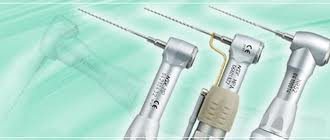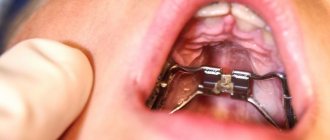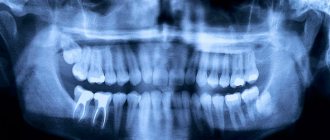“Aesthetic restoration in dentistry” - this concept combines a whole range of techniques and technologies aimed at restoring the anatomical shape of a damaged tooth, its aesthetic and functional characteristics. In other words, if the crown has a chip or crack, it is severely damaged or partially destroyed, the dentist can increase its shape using composite materials or completely cover it with veneer. There are other alternative options for correcting such defects. Read further in this article about what it is – artistic restoration of teeth.
Aesthetic restoration – the essence of the procedure and main indications
When answering the question of what artistic restoration is and when it is done, you should immediately note that this is a whole complex of different techniques, each of which is aimed at restoring the shape of a damaged or destroyed tooth, restoring the aesthetics and functionality of the smile as a whole. Among the indications for restoration, dental experts identify the following phenomena:
- pronounced yellowing or darkening of the enamel, pigmentation,
- thinning of the enamel layer,
- presence of chips and cracks, gaps between teeth, slightly crooked teeth,
- partial destruction of the crown,
- extensive caries,
- loss of old fillings, darkening of the material,
- Diastema is a large gap between the upper front teeth.
Artistic restoration will help restore damaged teeth.
Separate techniques are also used in cases where there may be no obvious dental indications for restoration. For example, when you are not satisfied with the shape or size of your teeth, when you want to make your smile look snow-white in Hollywood. In these cases, veneers and lumineers come to the rescue, but let’s talk about popular restoration methods in order.
Modern smile restoration techniques
Artistic restoration in its original meaning involves direct extension using composite materials or the installation of ultra-thin overlays on teeth - veneers or lumineers. Let's look at these two options in more detail.
Direct extension to restore crown shape
Restoration can be carried out using direct or indirect methods. The latter involves the use of orthopedic products that are created in the laboratory: veneers, inlays, bridges and prostheses. Direct artistic restoration looks like building up a damaged crown fragment with composite materials. You can evaluate the result of this procedure from the before and after photos.
The photo shows teeth before and after restoration
“Two years ago I fell off my bike, as a result of which a piece of my front tooth broke off. In fact, it was a small corner, but it was very noticeable when you smiled. The doctor suggested either putting veneers on all the front ones, which is very expensive, or restoring the shape by extensions. I chose the second option. The procedure went quickly, no pain. I was very pleased with the result! For 2 years, the extended area did not darken or break off. I hope it will continue to be the same.”
GenyaLipova, Saratov, from correspondence on the forum www.32top.ru
This is fast and convenient, given that the nanopolymers used today allow achieving high aesthetics and are also resistant to chewing loads. The service life can be from 3-4 to 7-8 years, depending on the quality of the material and its performance characteristics. Later in the article, the direct restoration method will be discussed in detail, but first you need to understand in what cases veneers and lumineers are installed.
Installation of veneers or lumineers
We are talking about the thinnest plates that are fixed on the front teeth using a special adhesive. In the case of veneers, the enamel of the frontal group of the teeth is first ground down - this makes it possible to increase the adhesion strength, as well as achieve an anatomically correct shape of each element. Lumineers are thinner overlays that do not require enamel preparation to be fixed. This option is more expensive, but durable and high quality. To create such microprostheses, ceramics, porcelain, zirconium, and ceramic composite are used.
You can also improve the aesthetics of your smile with veneers
On a note! Sometimes the concept of artistic restoration also includes the installation of inlays or crowns. This is if we consider the aesthetics of a smile as a whole. But in reality, dentists understand this concept as extensions with composite materials.
Stages of restoration using the direct method
Artistic restoration in its literal meaning involves building up a tooth directly in the patient’s mouth. To make this process more understandable, take a look at the step-by-step description:
- preparation: teeth are cleaned of plaque and hardened deposits, a shade is selected that best matches the color of real enamel,
- anesthesia: the procedure is performed under local anesthesia,
- if it is caries, then dead cells, food debris and destroyed tissues, and old filling material are removed from the cavity if the tooth has already been healed. If the tooth has been mechanically damaged, grinding of the defect will be required.
- insulation of the working area with a rubber dam: a piece of latex fabric is placed on the tooth to protect it from exposure to a humid environment,
- installation of a fiberglass pin: this stage is relevant for cases when the visible part of the tooth is destroyed by more than half, and the pulp was removed1. That is, in essence, we are dealing with a dead tooth. In such cases, there is a need to strengthen the root so that the filling does not fall out over time under the chewing load,
- modeling the anatomical shape of the crown - the material is applied in layers, which allows you to achieve the correct shape of the tooth and its natural appearance,
- At the final stage, the restored area is ground and polished.
The photo shows dental restoration using the direct method.
When using high-quality modern materials, the result of such work can last quite a long time - up to 7 years. Of course, much in this matter will depend on the initial size of the damage, as well as on the attitude of the patient himself to caring for his teeth and oral cavity.
Restoration of anterior teeth using composite filling materials –
In this chapter we will talk about how artistic restoration of the front teeth is carried out using specific examples - 1) in the first video you will see the replacement of an old, darkened restoration of a front tooth with a new one, 2) in the second video the restoration of an extensive chipped front tooth is shown. These videos perfectly demonstrate how artistic aesthetic dental restoration differs from conventional tooth filling.
For example, a special cast is used here to accurately restore the palatal surface of the tooth, as well as a layered restoration technique, which allows, by combining filling materials of different shades, to obtain an aesthetic result that is close to ideal (so that the restored part of the tooth does not differ in color and transparency from the natural tooth tissues). In fact, not all dentists have such skills, and there is no doubt that a certain artistic talent is needed.
Restoration of anterior teeth: video
The main stages of dental restoration:
- Preparation for restoration - at this stage it is necessary to hygienically clean the teeth from plaque and tartar, determine the color of the tooth being restored using a special scale and, in accordance with this, select the colors of the composite filling materials that will be used in the restoration process.
- Local anesthesia (if necessary)
- Drilling out tissues affected by caries - if an old unsatisfactory-looking restoration is being replaced, then the old filling is drilled out.
- Isolating a tooth from saliva - the use of cotton balls is almost universally a thing of history.
Their use does not allow reliably isolating the tooth from saliva, as well as from the patient’s wet breath, which also significantly worsens the quality and reliability of fillings and restorations made of composite filling materials. Now a rubber dam is used for this purpose. It is a latex scarf with holes for the teeth, which is pulled over the teeth. Composite dental restoration performed without reliable isolation from saliva and wet breath may not last long. Firstly, excessive moisture will cause a violation of the marginal seal of the filling to the tooth tissue, which can lead to the appearance of a dark strip or caries at the filling/tooth interface. Secondly, your restoration may simply fall out at one point, because... moisture impairs the adhesion of filling material to tooth tissue. - Fixing the pin in the canal - this stage is carried out if the crown of the tooth is destroyed by more than 1/2 and the tooth is pulpless. In this case, it is necessary to strengthen the filling by installing a pin, otherwise the restoration may fall out under load (24stoma.ru).
- Restoring the shape of a tooth with filling material – to make the tooth look natural, the layered restoration technique is used. In this case, layers of filling material of different shades and different transparency are applied to each other, which together then give the tooth a natural appearance. And this is real art.
- Finishing of the tooth – finishing should be understood as the final modeling of the tooth shape using burs, as well as grinding and polishing of the filling.
What to consider when restoring the appearance of your smile
We have looked at a brief step-by-step description of the process of how artistic dental restoration is done, but in fact, many important nuances must be taken into account in this work. To achieve the best quality and aesthetics, experts pay special attention to three important factors, described in more detail below.
Anatomical crown shape
It is very important to achieve maximum compliance with the anatomical shape of the tooth itself. Layer-by-layer application of light composites allows you to gradually recreate the necessary reliefs. If, after completing the restoration, the patient experiences discomfort when clenching his jaws, the doctor will adjust the crown. To ensure that the work is done efficiently and reliably, you should contact a good, experienced specialist.
Natural enamel shade
The restored area should not be conspicuous, especially if we are talking about the frontal group of teeth. Therefore, before starting the procedure, the dentist carefully selects the shade of the composite material using the Vita scale or uses 3D visualization computer programs for this - the latter can now be found in modern dental centers.
The Vita scale can be presented in the form of a palette
Transparency of dental tissues
The application of the composite in layers helps to achieve the required degree of transparency - a visual effect is created that makes the artificial part of the crown almost indistinguishable from a real one. To correct the incisal edge and cusps, materials are used that, after curing under a UV lamp, become almost transparent.
Restoration of non-carious lesions of anterior teeth
Treatment of non-carious lesions of hard dental tissues: this is what erosion looks like
Teeth with non-carious signs of damage also require restoration:
- enamel hypoplasia/hyperplasia;
- endemic fluorosis;
- various anomalies;
- hereditary factor;
- lesions resulting from eruption (trauma, erosion, surface and location defects, etc.).
When choosing a restoration technique, important points are taken into account:
- integrity of dental tissue;
- the extent of the outbreak;
- intensity of tissue breakdown;
- allergic reaction of the patient materials and drugs.
Just 15 years ago, dental defects due to non-carious lesions were solved by installing crowns. Now you can use both filling material and composite reflective material. If there is a slight curvature, wearing braces is no longer necessary; the problem can be eliminated in other ways.
It is worth noting that all aesthetic procedures are performed only after completion of treatment for acute or chronic dental diseases.
How to properly care for your smile after restoration
After direct restoration, you should not eat for another two hours, and it is better to abstain from solid foods for the whole day. On the same day, you should not drink coloring drinks, such as tea or coffee, or eat berries. The presence of artificial material on the crown requires increased hygiene, otherwise pigmentation may soon appear. In general, the requirements are still the same, but after restoration you definitely shouldn’t ignore them:
- daily brushing of teeth twice a day,
- rinsing after each meal, including special antiseptic agents,
- using floss after meals,
- cleaning with an irrigator is a small device with a powerful supply of water and air, which can be used as an additional device for daily care,
- regular visits to the dentist for preventative care.
Using hygiene products will help preserve your smile.
If the restored area becomes darkened or damaged, it is better to immediately contact your dentist. It should be noted that modern composite materials are characterized by increased wear resistance and allow achieving good aesthetic results for a long time.
Advantages and disadvantages
Let's look at the advantages and disadvantages of restoring anterior teeth in the table:
| Restoration of anterior teeth | |||
| Direct method | Indirect method | ||
| Advantages | Flaws | Advantages | Flaws |
| Speed of work completion (1-3 hours). | The service life of seals depends on compliance with installation technology and quality of execution (10-15 years). | The strength of the polymer material, the ability to choose the desired tone. | Expensiveness of the procedure and materials. |
| High quality when using light-curing materials | The success of direct restoration largely depends on the professionalism of the dentist. | Efficiency of restoration work. | Making an inlay takes time, which means one visit to the doctor is not enough. |
| Affordable cost of services and materials (several teeth can be restored in one visit). | After restoration, hygiene procedures should be carried out more carefully using special products and brushes. | Minimization of polymerization stress (as a consequence of shrinkage). | When installing veneers, a small layer of enamel is cut off, this is fraught with restorative treatment after the removal of the plates. |
| Correction of individual teeth or dentition. | You need to polish your teeth periodically to maintain their shine. | With proper care, veneers retain their integrity for at least 10 years. | Inlays and veneers require careful handling and care, otherwise the inserts may come off and even break. |
| Maximum tissue preservation. | Under the influence of time and other factors, the color of the teeth changes, but the polymer remains the same shade; the difference between the natural and artificial surface of the tooth will become noticeable. | Inlays and veneers prevent further tissue destruction. | Restoration is a complex type of work that only a professional can perform efficiently. Carelessness or errors in installation will shorten the service life of dental inserts. |
| The ability to eliminate a defect that has arisen as a result of the destruction of most of the tooth. | When restoring a tooth using the indirect method, the patient does not feel any discomfort. | ||
What problems may appear after recovery?
Over time, even modern light-curing materials darken, lose their shine and begin to stand out against the background of living enamel. For lateral molars, this may not be as critical as for the teeth of the frontal group, where such defects can clearly ruin a beautiful smile. If a larger-scale restoration was carried out, for example, a large part of the pulpless crown was restored, then the risk inevitably arises that the artificial material will break off. It must be taken into account that teeth with removed nerves are especially fragile. If the root is fractured at the same time, complete removal will be required.
Artificial material may break off
Alternative ways to restore the beauty of your smile
Artistic restoration using the direct method or using veneers is not the only option. There are also alternative, more radical measures that allow you to restore aesthetics and functionality to injured elements, for example, when there are contraindications to direct extensions and veneers. Let's look at them in a little more detail.
Installation of an artificial crown
Prosthetics with crowns are performed in case of severe destruction of the visible part of the tooth. The root is strengthened with a pin, and an artificial crown made of ceramics, metal-ceramics or, for example, zirconium is fixed on top. Today there is a fairly wide selection of different materials, so patients have the opportunity to choose the best price-quality ratio.
The issue can also be resolved using crowns
If the root is also damaged, the doctor will suggest prosthetics with a crown supported by an implant. In this case, a one-stage implantation can be performed with the installation of a titanium rod in the socket immediately after tooth extraction. If there are contraindications to this technique, implantation can be carried out using a one-stage technology immediately with the installation of an artificial crown. Today this is a convenient and affordable opportunity to restore a lost tooth in the fastest, most correct and reliable way.
Dental restoration with inlays
In essence, we are talking about a large filling that is created in the laboratory using impressions of the patient’s jaws. The finished product accurately follows the shape of the cavity and can ensure the tightest possible fit of the material to the dental tissues.
Important! The restoration tab should not be confused with the stump insert. The first is a large filling, the second serves as a support for an artificial crown if the tooth is destroyed by more than 2/3.
The photo shows dental inlays
Such inlays are indicated in cases where the crown is destroyed by caries by more than a third. They are used to restore only lateral molars. To cover defects in the front teeth, veneers and lumineers are used.
Correcting curvature with braces
If the problem is that the teeth are initially in the wrong position, you will need to undergo orthodontic treatment. Most often, in such cases, permanent braces are prescribed. And if veneers help hide minor curvatures or gaps between teeth, more complex anomalies cannot be corrected with thin overlays. But today, manufacturers of modern brace systems offer a fairly wide variety of different models, including those made from materials that meet the highest standards of aesthetics.
Braces - good for correcting malocclusion
Ceramic and sapphire braces are practically invisible on the teeth, while metal lingual braces are attached on the inside side by side. You just need to take into account that treatment with such systems will not be very cheap. The most expensive will be lingual models - they are completely invisible to others, successfully cope with complex defects, and do not prolong the treatment period. Ceramic and sapphire are distinguished by easy sliding of the arc in perfectly smooth grooves, which is why they do not have sufficient impact on problem areas. Treatment with them lasts longer than with metal ones. The latter, by the way, are considered the most budgetary, but at the same time the most effective option.
Flaws
Restorations have some disadvantages:
- Composite fillings can darken and change color over time. In addition, they may lose the shine that real teeth have. If the restoration was carried out on the front teeth, then this trouble will significantly affect the aesthetics. Therefore, such restorations will have to be replaced every few years.
- Possibility of breakdown. Risk factors include pulpless teeth, as well as teeth restored completely from the root. If the chewing load on the tooth is exceeded, tooth fracture or root fracture may occur. And then the tooth will have to be removed.
Approximate prices
How much restoration will cost directly depends on the scale of the problem and the chosen restoration method. If the damage is minor, such as a small chip on a front tooth, then the cost of restoring its shape using the direct method will be about 1,500-2,000 rubles. This includes anesthesia (250-350 rubles) and light-polymer material (about 1000 rubles). It’s another matter if the crown is destroyed by more than half. The cost of such a restoration without installing a pin will be approximately 3500-4000 rubles. Restoring a completely destroyed crown consists of the following components:
- use of anesthetic – 250-350 rubles,
- rubber dam (isolation of the working area from saliva) – about 600 rubles,
- sterile kit for a doctor – 150 rubles,
- recreating the anatomical shape of a tooth using light-curing composites – 3500-5000 rubles,
- installation of a fiberglass pin – 1500 rubles.
The total cost of complete tooth restoration in Moscow varies from 5 to 7 thousand rubles. Pricing is also influenced by the individual characteristics of the clinical picture, the status of the dental clinic, and the region of treatment.
Separately, you can consider the current prices for veneers made from different materials. Approximate prices are presented in the table below.
| Types of modern veneers | Approximate prices for 1 veneer |
| E.max ceramic | 30 thousand rubles. |
| Zirconium veneers | 25 thousand rubles. |
| Ceramic composite linings | 20 thousand rubles. |
| DUO | 45 thousand rubles. |
| Cerinate | 65 thousand rubles. |
There is also an option with lumineers - they are even thinner than veneers, but do not require grinding of living enamel and allow you to create the smile of your dreams in just a couple of visits to the dentist. True, such a restoration will cost an order of magnitude more.
Today there are many opportunities to create a truly Hollywood smile - snow-white and flawlessly even. Another thing is that such radical measures require quite impressive financial investments. If artistic restoration is not a whim for you, but a necessity, then carefully choose a clinic and a doctor to get a high-quality, aesthetic and durable result.
Ceramic veneers
Despite the fact that veneering has appeared quite recently, this procedure already has many fans. After all, ceramics have almost no disadvantages. It will not fade or change its original color over time.
It is advisable to use ceramic veneers in the following cases:
- the need to restore the front tooth by more than 1/3 of it;
- What is important is the long-term effect of the restoration, which will not lose its aesthetics over time;
- if necessary, remove the cutting edges.
Veneers will allow teeth to become light, not different in texture from their neighbors. Unlike composite materials, even after years (at least 3) they will remain in their original form, without darkening or staining. That is, their use is more practical and durable.
In this case, the choice in favor of veneer or composite material should remain with the specialist. After all, only the doctor knows what is best for the patient in his particular case. The dentist should tell the patient about both methods of restoration, including their cost, so that he can also participate in the choice, if any.











